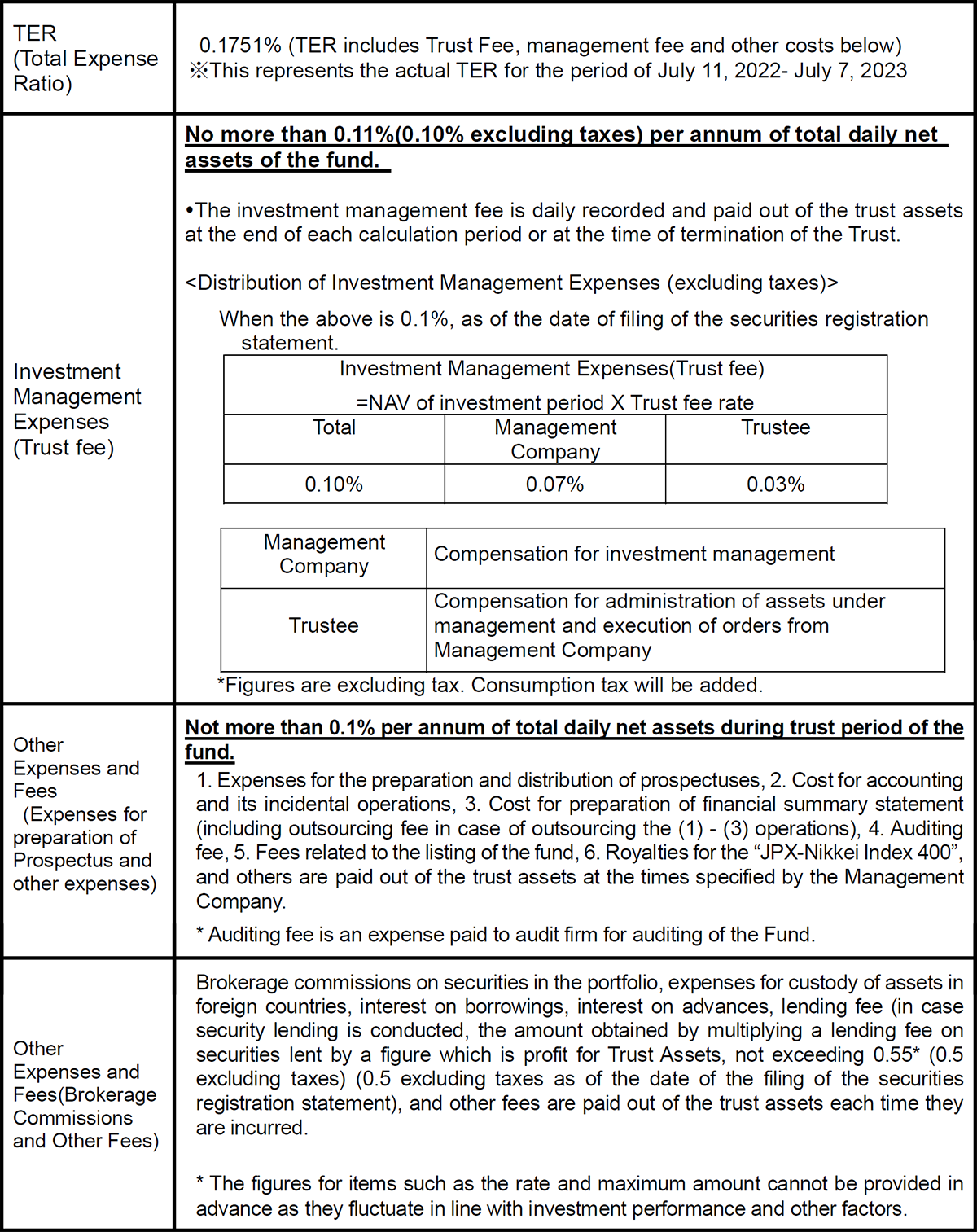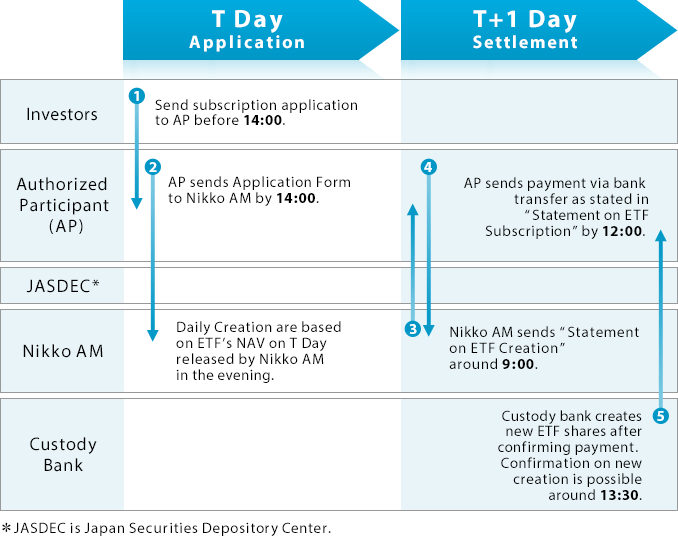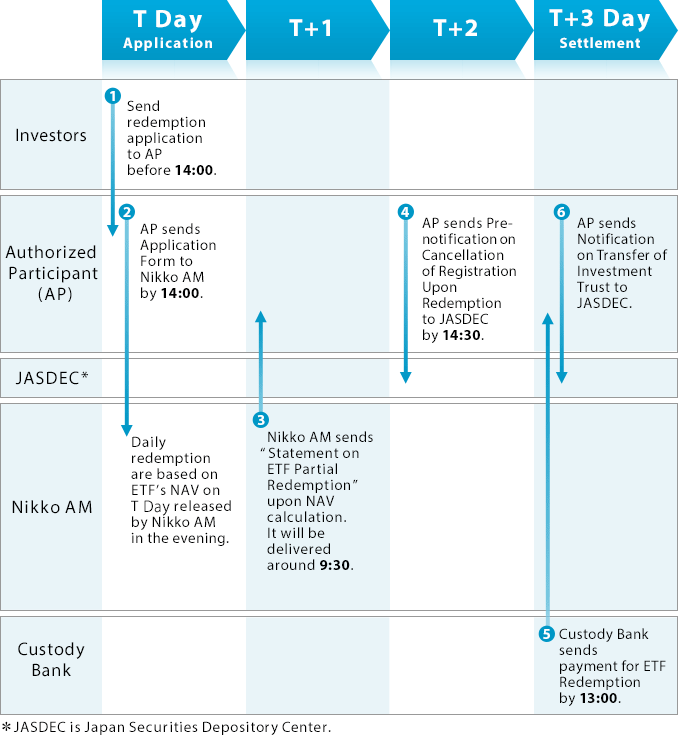On September 1, 2025, Nikko Asset Management Co., Ltd. will change its name to Amova Asset Management Co., Ltd.
The fund seeks to achieve a NAV that closely correlates with the movement of the JPX-Nikkei Index 400 by investing in shares of the component stocks of the JPX-Nikkei Index 400, and maintaining, in principle, a portfolio constructed consistent with the calculation method of the JPX-Nikkei Index 400.
| Fund Name | Listed Index Fund JPX Nikkei Index 400 Open-ended type/Domestic/Stocks/ETF/Index fund |
| Listed Exchange | Tokyo Stock Exchange |
| Issue Code | 1592 |
| Targeted Investments | This fund mainly invests in stock issues adopted for JPX Nikkei Index 400. |
| Date Listed | 28 January 2014 (launched on 27 January 2014) |
| Exchange Trading Unit | 1 unit |
| Trust period | Unlimited |
| Computation Period | Every year, 9 Jan - 8 Jul, 9 Jul - 8 Jan |
| Closing Date | Every year, the 8th day of January and July |
| Dividends | All revenue from dividends arising from the trust assets will be, in principle, paid as dividends on the last day of the fiscal year after deducting expenses. *There is no guarantee on the payment or the amount of dividend. |
Fund Expenses
■Expenses to be borne directly by investors
| Subscription Fee | Independently set by Distributors *Please contact your Distributor for further information. *Subscription Fee is compensation for explanation and information providing about the Fund or investment environment, and is also including expense of clerical processing of the subscription. |
| Exchange Fee | Independently set by Distributors *Please contact your Distributor for further information. *Exchange Fee is compensation for clerical processing of the exchange. |
| Amount to be Retained in Trust Assets | None. |
■Costs paid indirectly by the customer for the trust assets (paid from the fund)
| TER (Total Expense Ratio) |
0.16% (TER includes Trust Fee, management fee and other costs below) Please refer to the prospectus for details. |

The total amount of expenses of the Fund to be borne by investors varies according to holding length and investment status, and thus cannot be shown.
Major Investment Restrictions
|
Trustee Companies
|
The JPX-Nikkei Index 400 is a stock index of the top 400 stocks selected from ordinary shares listed on the Tokyo Stock Exchange's Prime Market, Standard Market and Growth Market. Selection of constituent stocks is based on 1) screening of eligibility criteria and market liquidity indicators, 2) quantitative indicator-based scoring (3 year average ROE, 3 year cumulative operating profit, market capitalization), and 3) qualitative factor-based scoring (appointment of independent outside directors, IFRS adoption, disclosure of earnings in English). The calculation method employs the closing price of August 30, 2013 as its base date, assigns a value of 10,000 as that day's market capitalization, and indexes market capitalization thereafter.

* Market capitalization of index at the time of calculation is a total of the market value based on the number of shares of index for each issue.
Further Information
Japan Exchange Group (JPX)
Japan Exchange Group publishes summaries and lists of the ETFs, as well as other valuable information on their website.
S&P Global
- Listed ETF iNav
Please click this link to see the iNAV.
Nikkei Inc.
*Link to external sites.
Copyrights and Other Rights of JPX-Nikkei Index 400
The JPX-Nikkei Index 400 will be managed via a proprietary calculation method that was co-developed by JPX Market Innovation & Research, Inc.(hereinafter, “JPX soken”) and the Nikkei Inc. (hereinafter, “Nikkei”). JPX soken and the Nikkei hold the copyrights and all intellectual property rights for the calculation methods of the JPX-Nikkei Index 400.
JPX soken, Japan Exchange Group, Inc. and the Nikkei hold all trademark rights and intellectual property rights concerning the logo of the JPX-Nikkei Index 400.
The management of the Listed Index Fund JPX-Nikkei Index 400 is the responsibility of investment trust and management companies. JPX soken or the Nikkei bear no responsibility in regard to the management and trading of the fund.
It is not the duty of JPX soken and the Nikkei to continuously publicize the JPX-Nikkei Index 400 and the two parties are not responsible for publicized errors, delays or stoppages.
JPX soken and the Nikkei hold the right to change the stocks that make up the JPX-Nikkei Index 400, the calculation method and other aspects of the JPX-Nikkei 400, as well as the right to stop publication.
This Fund can be applied for as a cash creation and a cash redemption at Authorised Participants in addition to the Tokyo Stock Exchange.
Authorized Participants
- SMBC Nikko Securities Inc.
- Citigroup Global Markets Japan Inc.
- ABN AMRO Clearing Tokyo Co., Ltd.
- BNP Paribas Securities (Japan) Limited
- BofA Securities Japan Co., Ltd.
- Daiwa Securities Co. Ltd.
- Goldman Sachs (Japan) Co., Ltd.
- JPMorgan Securities Japan Co., Ltd.
- Mitsubishi UFJ Morgan Stanley Securities Co., Ltd.
- Mizuho Securities Co., Ltd.
- Morgan Stanley MUFG Securities Co., Ltd.
- Nomura Securities Co., Ltd.
- Societe Generale Securities Japan Limited
- Tokai Tokyo Securities Co.,Ltd.
- UBS Securities Japan Co.,Ltd.
Daily Creation and redemption are based on ETF's NAV calculated in early evening. Confirm non-tradable days by referring to trading calendar on our official homepage. Basket for creation is continually-updated on our official homepage.
Basically sell/buy underlying asset at last price of T day's market.
The flow chart below is showing the creation/redemption process for Nikko AM ETFs. Please note that transactions cannot be processed for days on which applications are not accepted.
Creation Flow for Cash Creation/Redemption Type ETFs

Redemption flow for in-kind Creation/Redemption Type ETF

Invested principal is not guaranteed and may incur losses where the value of your investment principal will fall below par as the result of a decline in market price or the NAV. All gains and losses from the management of the fund belong to the investor (beneficiary). This fund also differs from bank deposits.
The fund invests primarily in stocks. The NAV of the fund may fall and investors may suffer losses due to declines in stock prices or deterioration in the financial conditions and business performance of equity issuers.
Major risks are as follows:
1. Price Fluctuation Risk
In general, the price of a stock is vulnerable to company information on growth potential and profitability and changes in such information. In addition, stock prices are also vulnerable to domestic and overseas economic and political conditions and other factors. There is a risk that this fund may incur major losses in the event of stock price fluctuations or unforeseen fluctuations in stock liquidity.
2. Liquidity Risk
In the event of small market scale or trading volume, when acquiring or selling securities, there is the risk of not being able to trade at the desired price due to actual market conditions as a result of the effects of large trading volume, the risk of being unable to sell at the valuation price, or the risk of trading volume being limited regardless of price highs and lows. As a result, there is the risk of suffering incalculable losses.
3. Credit Risk
In general, there is a risk that this fund may incur significant losses in the event that a major crisis directly or indirectly affects the management of companies in which the fund has made investments in. Due to concerns regarding default or bankruptcy, the stock price of those companies could plummet (the value could even fall to zero), causing the fund's NAV to fall. The fund could become delisted in the event it should violate certain criteria established by financial instruments exchanges. Concerns regarding possible delisting or delisting itself can cause the stock of the issuing company to fall, leading to a material loss in the fund.
The fund's capital may be managed with short-term financial assets such as call loans or transferable certificates of deposit, however losses may be incurred as a result of default by purchasing counterparties. This can also contribute to a decline in the fund's NAV.
4. Currency Fluctuation Risk
In the case of foreign currency-denominated assets, generally if the foreign exchange market moves so that the yen appreciates against the currency in which the fund's assets are held, the fund's NAV may depreciate as a result.
5. Security-lending Risk
Lending of securities is accompanied by counterparty risks (default or cancellation of lending agreements as a result of bankruptcy) and as a result, there is a risk that the fund will incur unexpected losses. Following a default or cancellation of a lending agreement, when liquidation procedures are implemented using the collateral set aside in the lending agreement, the procurement cost of buying back the securities may exceed the amount of collateral due to market price fluctuations. In such cases, the fund is required to pay the difference, which may cause the fund to incur losses.
Risk of divergence between the JPX-Nikkei Index 400 and the fund's NAV
This fund will aim to match NAV volatility with the volatility of the JPX-Nikkei Index 400. Due to the following factors, however, it cannot guarantee that movements in the fund's NAV will always be consistent with that index.
- Market impact when buying or selling individual stocks as it adjusts its portfolio in response to changes in the stocks that comprise the JPX-Nikkei Index 400 and capital changes among companies, as well as various expenses, including trust fees, brokerage commissions, and audit fees.
- Management fees from the lending of securities or dividends of incorporated issues.
- The disparity between price movements of derivative transactions, such as futures trading, and that of some or all of the issues that comprise the JPX-Nikkei Index 400.
Divergence between market prices at which stocks are traded on exchanges and the fund's NAV
This fund is listed on the Tokyo Stock Exchange and traded publicly, however, its market price will depend mainly on demand for the fund, its investment performance, and how attractive it is to investors in comparison with alternative investments. Accordingly, it is not possible to predict whether the fund's market price will trade above or below the NAV.
* Factors that contribute to NAV fluctuations are not limited to those listed above.
Additional Considerations
- This distribution material has been created by Nikko Asset Management for the purpose of enhancing investors understanding of the Listed Index Fund JPX Nikkei Index 400.
- The provisions stipulated in Article 37-6 of the Financial Instruments and Exchange Act ("cooling-off period") do not apply to fund transactions.
- This fund differs from deposits or insurance policies in that it is not protected by the Deposit Insurance Corporation of Japan or the Policyholders Protection Corporation of Japan. Furthermore, units purchased from registered financial institutions, such as banks, are exempt from compensation from the Japan Investor Protection Fund.
- When the Fund faces big redemption causing short term cash requirement or sudden change in the main trading market condition, there can be temporal decline in the liquidity of holding assets, resulting in the risks that Fund unable to trade securities at the expected market prices or appraised prices, or encounters limitation in trading volume. This may result in the negative influence on NAV, suspension of redemption applications, or delay in making payment of redemption.
- When applying to invest in this fund, please make the decision to invest carefully after taking the time to read in detail the pre-agreement documents provided to you and other relevant material.












